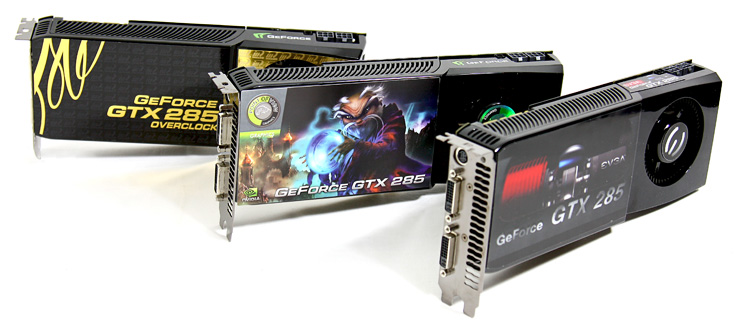Introduction

GeForce GTX 285 review | 2-way-SLI | 3-way SLI As much as Intel has a Tick-Tock (one year new architecture - following year refresh architecture) design strategy, so does pretty much any chipset manufacturer on this globe. So when NVIDIA released their series GTX 200 products in the summer of last year, it was no surprise to see a spin-off product anytime soon. For NVIDIA this probably is a much welcomed respin product, as the GTX 200 series was based on a 65nm fabrication process. Since the GTX200 series are among the most powerful GPU on this planet, it made the GPU big with an astounding 1.4 billion transistors. Monolithic, was the stigma that got attached to the design.
As much as Intel has a Tick-Tock (one year new architecture - following year refresh architecture) design strategy, so does pretty much any chipset manufacturer on this globe. So when NVIDIA released their series GTX 200 products in the summer of last year, it was no surprise to see a spin-off product anytime soon. For NVIDIA this probably is a much welcomed respin product, as the GTX 200 series was based on a 65nm fabrication process. Since the GTX200 series are among the most powerful GPU on this planet, it made the GPU big with an astounding 1.4 billion transistors. Monolithic, was the stigma that got attached to the design.
As a result the NVIDIA GTX 200 series GPUs have a huge die measuring 24 x 24 mm. Big die's have one problem, you really can't fit many chips on a 300mm wafer. And if you take into account that yields at first will be average.. so as a chip manufacturer you pretty much you'd want to make that product smaller for that plus a number of other reasons.
This is what the GTX 285 is all about, not shocking ground breaking new graphics architecture, yet a move towards the 55nm fabrication process, making that chip (GT200b) die size smaller, aim for better yields, and in the end, a product that requires less voltage. Last month NVIDIA already silently upgraded their GeForce GTX 260 products towards this very same 55nm chip. And for the GTX 260 the result for you as an end-consumer are ... well, close to NIL really.
For the update from GTX 280 towards GTX 285 the end user this means a marginally increase in performance though. So that's what we'll be looking at today. The GeForce GTX 280 is now updated and upgraded, the product will be called GeForce GTX 285, fabricated on that 55nm node, and we want to have a closer look at it.
So, not only will we look at a GeForce GTX 285 card. We thought we would go one further, we asked several of NVIDIA's board partners to send in their best. And so they did, this review will cover:
- EVGA GeForce GTX 285 SSC
- Inno3D GeForce GTX 285 OC
- Point of View GeForce GTX 285 EXO
That should be fairly interesting, right? All board partners offering the same product, yet different. We'll also go a little extravagant today as we'll also test 2-way and 3-way SLI performance based on these GTX 285 cards. So you better grab yourself a cup of coffee, next page please.

